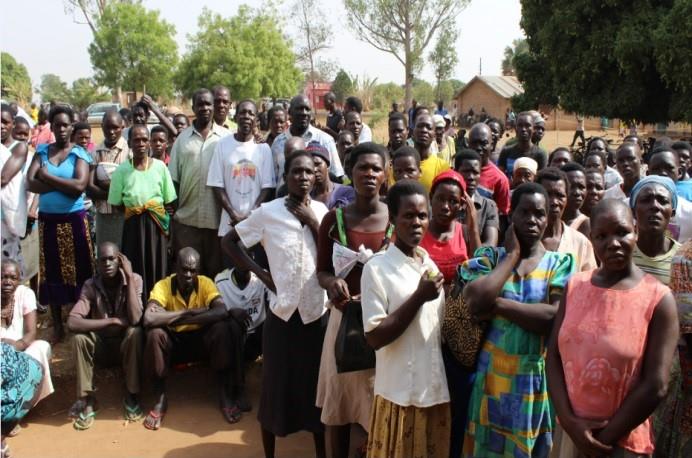
In 2017, USAID’s Malaria Action Program for Districts distributed 1,000,000 ITNs to 1,978,114 persons in three districts in Uganda.
Background
Arua, Koboko and Nebbi are three districts located in West Nile Region, Uganda, with a population of over 1.5 million. In these districts, like in most parts of the country, malaria is a serious public health problem. In 2016, over 700,000 confirmed or suspected malaria cases were reported to public health facilities in these three districts.
USAID’s Malaria Action Program for Districts conducted a long-lasting insecticide-treated mosquito net (LLIN) distribution campaign in February and March 2017 as part of its objectives to increase the impact and reach of malaria prevention services. The project took a four step approach in conducting the LLIN distribution campaign: 1) community sensitization, 2) community-led registration of households, 3) data-entry and verification, and 4) community-led distribution. During community sensitization, emphasis was placed on social behavior change communication (SBCC) to reach all targeted communities with relevant and effective messages on use of LLINs.
Promoting a Culture of Net Use
Prior to household registration, the project team convened a regional advocacy meeting in Arua district with local leaders from the three districts. These included district health officers, resident district commissioners, district health team, chief administrative officers and local council (LC) chairpersons. Local leaders’ understanding of malaria prevention and their engagement in promoting positive behavior towards malaria prevention was key to the campaign’s success.
During this meeting, the project team shared malaria prevention strategies and messages to the local leaders who would then share these with their own communities.
The leaders committed to promoting a culture of net use, highlighting that a significant change in mindset and behavior towards prevention can lead to a ‘malaria-free world’. They shared a vision of a malaria-free district, where communities would have higher levels of productivity, due to less money lost on treating malaria and more time spent on income-generating activities. Leaders also raised the need for adequate community-led mobilization for household registration and subsequent LLIN collection, as well as working with the local wanaichi to create a culture of net use.

Left to right): A mother in Rhino Camp receives an LLINS; A demonstration on how to use an LLIN; A beneficiary registering to receive LLINS at Aiivu sub county, Terego village in Arua District Successes and Impact
Successes and Impact
The high turnout of community members to receive their nets can be credited to the effective community-led mobilization, impact of the malaria messages promoting positive prevention behaviors like net use. In Nebbi district, for example, leaders indicated that sensitizing the community before the distribution was key to its success:
“… you will realize on the day of distribution that there is going to be a high turnout of community members […] this has been shown by the registration after community’s sensitization by political leaders and other stakeholders. When you look at the registration, you feel very happy that these people have been sensitized. So the registration was 100 percent successful. Everybody registered because they understood why nets are being distributed to them. So that has been a very big achievement.”
– Olweku Fred Jibril, Secretary for Social Services, Nebbi district
The campaign in the three districts reached 98 percent of households registered during the pre-campaign registration; 91 percent of the population was sleeping under a net (data reported by the district supervisors in the three West Nile districts in the wave 1 review meeting).
The net distribution campaign was welcomed by the community members and health workers alike. Below are what some of the beneficiaries had to say:
“…On behalf of my people, we are very happy for this service, in fact, we have been having problems of malaria [for a long time] and case numbers had become so high that we could not manage with the current drugs in the hospitals. So I think with this, it is going to improve our health.”
– Achong Emmanuel, area LCI Oufa Village, Aiivu Sub County
“The reason why I have come for the net is because we have so many mosquitoes and there is a high rate of malaria, as we are along the river. The mosquitoes are very many. Without nets, there is no sleep here…”
– Net recipient, Rhino Camp
Lessons and Next Steps
An SBCC approach before the net distribution campaign allowed community leaders and members to be engaged in education around malaria prevention.
Community involvement is instrumental in ensuring a well-supported distribution and to achieve a high proportion of immediate net uptake and sustained use of nets.
USAID’s Malaria Action Program for Districts will continue to run a SBCC campaign promoting the correct and consistent use of nets using a community led approach championed by the local council leaders in order to create a culture of net use.
